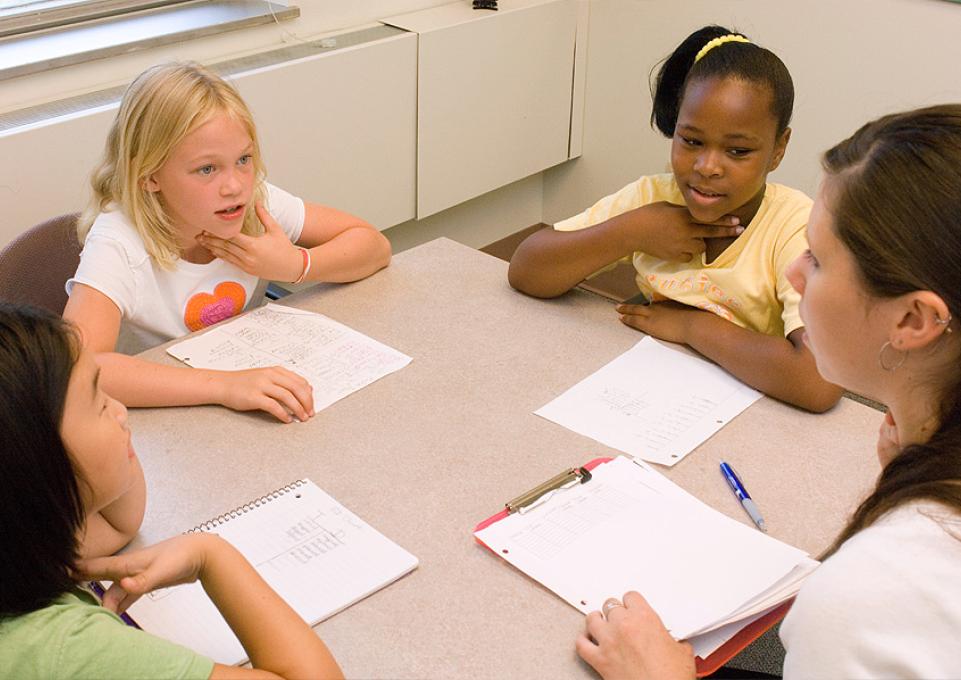
In 1956, Betty Gallagher, a Buffalo State theater professor who specialized in public speaking, wanted to help children and adults speak more clearly — whether they struggled with a speech impediment or simply wanted to improve their elocution.
Gallagher, who passed away in 1992, worked with the college to open a speech clinic in Ketchum Hall as a resource to the community. In the ‘60s and ‘70s, the Speech-Language Hearing Clinic shifted its focus toward treating individuals with disabilities and operated under the auspices of the Exceptional Education Department. The clinic was staffed by an impressive slate of faculty members who specialized in voice disorders, stuttering, audiology, and provided supervision for students enrolled in the department.
“This was before the federal law was passed requiring public schools to provide services to children with disabilities,” noted professor emeritus Dolores Battle, who joined the faculty in 1970 and specialized in children’s language disorders in the clinic. She later served as president of the American Speech-Language-Hearing Association (ASHA).
“Families had to seek out special services and they found them here,” she said. “One thing the college did that was very innovative at the time was host a summer clinic for children with a cleft palate. They lived in the dorms and received treatment for six weeks.”
Celebrating its 60th anniversary this year, the clinic continues to offer an invaluable service to Western New York. As part of the college’s Speech-Language Pathology Department, state-licensed faculty members closely supervise graduate students while they learn to evaluate and treat communication disorders in people of all ages—from the 3-year-old on the autism spectrum to the 70-year-old who suffered a stroke.
“Back when the program started, people didn’t recognize communication disorders the way we do today,” Battle said. “We never would have considered treating swallowing disorders, for instance, or working with teens who need help with literacy.”
Temporarily housed in a suite of offices in Buckham Hall, the clinic is open to clients throughout the year and also offers intensive specialty clinics for aphasia, language-literacy, and auditory processing. The clinic will return to the first floor of Caudell Hall when the renovated building reopens in 2017.
“There are really great supervisors and teachers who want you to succeed,” said Kathleen Yetman, a Long Island, New York, native who just completed her first year in the program. “They are invested in you and your clinic work.”
One of Yetman’s favorite experiences thus far has been working with a 65-year-old man with aphasia.
“We saw him do things he’d never done before,” she said. “Seeing the progress he’s made and knowing I was part of it was the best feeling.”
The clinic continues to offer expertise in the areas of articulation, voice, language disorders, stuttering, and hearing. Its faculty remain committed not only to students but to the field of speech-language pathology. For instance, Constance Qualls, professor and former chair of the department, served as vice president of the ASHA and other faculty members have served in leadership roles in state and national organizations, noted clinic director Karen Bailey-Jones.
Bailey-Jones joined the faculty in 1992 and became clinic director in 1994 at a time when standards for speech-language pathologists were changing and the department was going through its ASHA accreditation process. By the mid-90s, the ASHA required students to have more in-house experience, more rigorous instruction, and better preparation for employment.
Even before they enter the graduate program, students must excel. Approximately 200 applicants vie for the 30 to 35 spots each year.
“It’s a very labor-intensive program, and we want to make sure that students have the academic ability to do it,” Bailey-Jones said. “By the time they finish, students will have earned 400 clinic hours.”
Along with classwork and three semesters in the clinic, students are placed in community program affiliates, including schools and hospitals, for two additional semesters. The rigorous requirements have garnered national attention. This year U.S. News and World Report ranked Buffalo State within the top 100 speech-language pathology graduate programs in the country.
“We know that when our graduates leave the program, they will be highly employable,” Bailey-Jones said.
According to the U.S. Bureau of Labor Statistics, employment of speech-language pathologists is projected to grow by more than 20 percent by 2024.
“While it’s impossible to know everything about the field, the clinic staff trains you how to find the information and how to implement therapies even for something you’ve never seen before,” Yetman said. “They train you well before you leave the program.”
For Battle seeing the clinic flourishing 46 years after she joined it is rewarding.
“Early on, we worked with many children who were living on the outskirts of society due to their disabilities,” Battle said. “We treated them and their families with the respect they deserved, and helped them achieve a higher level of comprehension and fluency. For that, I am very proud.”
